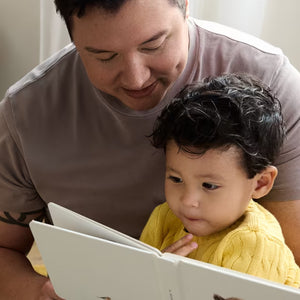If you have babies or toddlers in daycare, you likely have some unique sleep challenges, questions, and situations. I'd love to talk through those with you.
Please know that you’re not alone as you transition to daycare. All of my classes are completely appropriate for families who have babies or toddlers in daycare.
Can we still have a great little sleeper if our baby needs to be at daycare?
YES! We have so many daycare babies with parents on the Taking Cara Babies team and in our community who have successful nights even with irregular nap schedules at daycare.
If you’re using any of my classes, it’s just fine to focus on nights at home and let go of naps at daycare. You can still make progress towards great sleep and maintain your great little sleeper even if you don't have control over what happens during the day.
Will my child have a sleep regression after starting daycare?
Sometimes, daycare sleep can impact nights and naps at home. Babies and toddlers typically take some time to adjust to napping in a different child care environment.
BUT can I tell you something? Daycare sleepers typically become the best nappers ... eventually. At first though, some babies get hours less daytime sleep than they would at home. An overtired baby may sleep poorly at night, which can result in nap struggles again the next day. Little ones may also experience separation anxiety as they adjust to their new environment and caregivers.
Here are two ways to help ease the transition to napping at daycare:
-
Try an early bedtime. Because night sleep is more restorative than day sleep, an early bedtime is the best way to help an overtired baby or toddler. I know it can be tempting to offer a catnap when you get home from daycare, but this will push bedtime later. Instead, forgo the catnap and offer a bedtime as early as 6:00 pm. (For babies 5 months and younger, we may need to offer both the catnap and the early bedtime.)
-
Share with your child’s teacher about strategies that help your baby or toddler to nap well at home (your nap time routine, wake windows, environment, etc.). Be assured: your teacher wants your little one to get good naps too!
How long does it take a baby or toddler to adjust to napping at daycare?
It depends! While some little ones may adjust after a few days or weeks, others may take a couple of months to adjust to napping at daycare. Starting daycare is a big transition for you and your baby or toddler. Give your little one and yourself lots of grace during this adjustment, and be sure to check out my tips for how to help your baby or toddler nap at daycare.
What can I do if daycare requires my child to follow a schedule different than the schedule we follow at home?
I want to reassure you that you can still have a great sleeper even if your baby or toddler follows a different schedule on daycare days.
Many daycare centers do aim to follow a set schedule, as this is helpful for meeting both the needs of the children and staff. Some local and state regulations actually require child care providers to have a schedule in place.
Trust that your child care providers can handle it! Your baby and toddler will adjust with the consistency and routine of their daycare schedule. Yes, even if your baby or toddler’s daycare doesn’t follow wake windows. Yes, even if your little one is required to drop a nap (or keep a nap) when they’re not ready to do so at home.
If your little one is struggling with the transition to a new schedule at daycare, here are ways we can help:
-
Offer an early bedtime. This is always my first suggestion because it typically makes the biggest difference. Offer a bedtime as early as 6:00 pm. I know this doesn’t feel ideal for many families, but often the choice is to offer that early bedtime or deal with rough nights and early morning wakings. This won’t be forever, but can truly be so helpful for restoring lost daytime sleep!
-
Ask about options for your little one to take a tiny catnap. That may be as simple as allowing for a 20 minute nap in the morning or afternoon depending on which nap is being dropped and how your child is adjusting. For some babies and toddlers, a catnap can make a huge difference in preventing an overtired little one.
Why won’t daycare use swaddles, white noise, a pitch dark room, etc?
Simply put: they're not able or allowed to use them.
Here’s why those regulations or limitations might exist at daycare: Infant daycare teachers are trained to watch the rise and fall that indicates breathing, to look and listen for certain signs of distress, and to regularly check on sleeping babies. This requires that babies are never in a completely dark environment and, in many cases, without the sound machines that can be so soothing to babies.
For swaddling to be safe, we need to know the physical skills of each individual baby. This may not be possible in a child care center. We also know that many babies begin daycare around the same age we typically see those signs of rolling (about 3-4 months). To keep all babies as safe as possible, a universal no-swaddling policy makes sense.
Expert Tip: If your baby is accustomed to a swaddle at home but can’t use a swaddle at daycare, talk to your daycare provider about whether a swaddle transition like Swaddle Sleeves Sack (CARA10 saves you 10%) or Merlin’s Magic Sleep Suit could be an option. Please make sure to follow manufacturer’s guidelines to ensure a safe fit in these transitional products.
My baby or toddler won’t nap at daycare. What can we do to help?
This is something child care centers address every day. Out of necessity, daycare teachers find ways to help babies and toddlers sleep the best they can. It may not always look the same as sleep at home, but that’s okay. Teachers are often AMAZING at helping with sleep, and your child may shock you with their ability to adapt.
Try my daycare printable as an easy way to communicate your baby’s daily needs and preferences with your baby’s teachers. (Get the digital version of the daycare download here.)
If your baby or toddler has consistent nap struggles at daycare, here are a few ideas that you can discuss with your child’s teacher:
-
For younger babies with a still-strong Moro reflex, a swaddle transition like Swaddle Sleeves Sack (CARA10 saves you 10%) or Merlin’s Magic Sleep Suit may be worth considering.
-
Ask your baby or toddler’s teacher if it’s possible to follow the same schedule as home as much as possible.
-
Offer to bring a sleep sack from home.
-
For babies over 12 months old, ask about bringing a lovey or comfort object from home.
-
For babies or toddlers who seem to struggle with noises in the classroom, ask about bringing a portable sound machine to keep by your little one’s crib or sleep space.
-
Ask if it’s possible for your baby or toddler’s crib to be a bit farther away from any commotion.
-
Be patient. It can take time for babies and toddlers to adjust to napping in a new environment.
Please note: For some child care providers, the suggestions above simply aren’t options because of legal regulations, daycare policies, or individual baby considerations. Trust that your little one’s daycare will use all of the tools available to them to help your child.
My child’s daycare nap is ruining bedtime. How can we adjust?
If your family is a daycare family, the time and length of daycare naps are likely out of your control.
BUT there are components of your baby or toddler’s sleep that you can control:
1. The time your baby or toddler goes to bed. You may need to offer:
-
An earlier bedtime. If naps were short or ended early in the day, moving bedtime earlier (think 6:00-6:30 pm) can help prevent overtiredness. Often, little ones get less than the goal amount of total daytime sleep when they’re adjusting to daycare. We do want to aim for a full age-appropriate wake window before bedtime, but moving bedtime earlier gives your baby or toddler a chance to make up for missed daytime sleep.
-
A later bedtime. On the other hand, sometimes naps end too late in the day, last too long, or are offered when your toddler no longer needs a nap. In these cases, your baby or toddler may need a later bedtime (think 8:00 pm, or even a bit later). A later bedtime allows for active awake time to help fill your baby’s tired tank™ in order to be tired enough to fall asleep and stay asleep overnight.
2. How your baby or toddler naps at home.
-
Sleep environment. If your baby or toddler naps in a dark room with a sound machine at home, keep doing that! It doesn’t matter that daycare is brighter with the sound of music playing. Your goal while at home is to get the best possible nap. Little ones really do adjust and understand the difference between home and daycare.
-
Number of naps. If a different number of naps works better for your baby or toddler at home than the number of naps they’re taking at daycare, it’s okay for daycare days to look different. For example, if your baby was transitioned to one nap at daycare, but two naps works best at home, you don’t need to transition at home just yet. Or if your toddler stopped napping at home but still naps at daycare, that’s okay.
3. Your baby’s wind down routine.
Having a consistent bedtime routine for your baby or toddler is a great way to wind down and connect after everyone’s busy day. It cues your little one’s brain that it’s time to transition to sleepy time and is a big part of bedtime success.
Toddler Tip: Now, let’s talk about what to do if your toddler no longer needs a nap and daycare naps are causing sleep struggles at home. Try talking with your child’s teachers about whether they can move the nap earlier, cap the nap at an hour, or allow your toddler to play quietly during nap time. If that’s not possible, know that bedtime will need to be pushed later.
How do I handle the car ride home? Should I try to keep my baby awake?
If you can easily keep your little one awake in the car, do it! If your baby or toddler is tired when you arrive at home, aim for an early bedtime instead of offering a catnap. Night sleep is more restorative than day sleep, so that early bedtime would be my first recommendation.
If your baby or toddler is exhausted after daycare and your drive is longer than a few minutes, keeping them awake may be a virtual impossibility. Please hear me: A catnap on the drive home is unlikely to keep you from great nights. Here’s what I recommend if your baby or toddler falls asleep during the car ride home from daycare:
If the car nap is less than 30 minutes, add 10-45 minutes to the current wake window to help your baby or toddler be tired enough to fall asleep at bedtime.
If the car nap is 30 minutes or longer, count the car nap as a full nap and offer a full wake window before bedtime.
Why does my toddler nap at daycare but not at home?
It can be frustrating and even confusing when your toddler naps well at daycare but won’t nap at home.
There are a few reasons this often happens:
-
Routine. Most child care providers follow a predictable routine (as little ones really do thrive on predictability), and this consistency cues your toddler that it’s time for a nap.
-
Peers. It helps that your toddler’s peers follow the same routine and also nap at the designated time. This kind of peer pressure can motivate your toddler to nap- they know they’re not missing out on anything.
-
Stimulation. Lastly, the day-to-day activities of daycare are mentally and physically stimulating for your toddler. With all that activity, their little body may need the extra rest from a nap.
If your toddler is refusing to nap at home but does actually still need a nap, let’s first look at reasons they’re refusing to nap (Are wake windows off? Is their room set up for success? Do they have a good routine?). Then keep in mind, we want to move bedtime earlier on days naps are refused to avoid overtiredness.
Expert Tip: Some toddlers may protest or refuse to nap at home if they’re experiencing separation anxiety. Each day, aim to spend 10-15 minutes of one-on-one time with your toddler. This distraction-free time for connection helps fulfill your toddler’s desire for closeness and can ease anxieties at times of separation, like a nap.
What can I do if my baby won’t eat at daycare?
I know it can be so hard when your baby won’t eat at daycare.
Your little one might not be eating well at daycare because they’re:
-
Distracted while eating. Daycare is an exciting place to be! There are new faces, new sounds, new smells, new everything. This can make it difficult for your baby or toddler to focus on eating. Check out how to help if your little one is distracted while eating.
-
Overtired. So often, babies and toddlers are overtired when adjusting to child care. Naps are short or refused. They’re overstimulated by their new environment. Being overtired can lead to being less interested in eating. This will likely be temporary, but you can help by continuing to offer naps at home however your little one will take them and adjusting bedtime as needed.
-
Transitioning to bottle feeding. For babies who have not had much or any experience with bottles prior to starting daycare, there may be a bit of an adjustment period. Aim for full feedings when you’re at home with your baby. Offering a dream feed can help if your baby is getting significantly less calories during the day while adjusting to daycare.
-
Getting too much sleep at daycare. Too much daytime sleep may mean missing important daytime calories, which then leads to a baby being hungry at night. This is what we call reverse cycling. The best way to deal with this? Talk to your child’s teacher about wake window routines and your baby's caloric needs.
Please be sure to speak with your pediatrician if you have any concerns about your child’s intake or growth.
Can we make progress with sleep training or nap training if our child attends daycare?
Yes!
Babies and toddlers can usually tell the difference between sleeping at daycare vs. sleeping at home. Try not to stress about what happens during the day in the child care environment, and continue to use the same tools and techniques you’ve learned from my classes when you have your little one with you at night. That sleep progress will come.
Parents who have a great little sleeper after taking my 5-24 Month Collection or Toddler Sleep Training often fear the strategies that daycare uses for naps will destroy the success they saw with sleep training. Let me assure you: this rarely causes major problems. That doesn’t mean your transition won’t cause a sleep hiccup, but if you give it some time and remain consistent at home, your great little sleeper will return.
Let me show you what real parents have to say:
What is your best advice for daycare families?
1) The RIGHT daycare is so important.
Knowing that you can trust the providers and facility where you leave your child during the day is everything. You can use my Safe Sleep Checklist to ask questions or review child care policies.
2) Babies and toddlers can thrive at daycare.
Little ones can often adapt to different situations better than we ever expect. Those who are at daycare learn to sleep out of swaddles, nap in muted light, and stay on cots for nap time. They can be securely attached to their parents and at the same time learn to trust other caring adults. Daycare can be a place where babies and toddlers sleep well and truly thrive.
3) Daycare teachers are part of your team.
Teachers in the baby and toddler rooms choose to surround themselves with little children and are so gifted in loving little ones well. When parents view daycare caregivers as a trusted part of their support team, communication is usually productive and encouraging to everyone involved.
4) Daytime sleep really is different than nighttime sleep.
Babies and toddlers have all sorts of different sleep experiences at daycare; some sleeping very well and some struggling during the day. Nighttime sleep can still be successful if you have a plan you can trust and a willingness to be flexible with the parts you can control.
5) There’s no reason to stop what’s working at home.
Your child is smart and can tell the difference between home and daycare. If swaddling, using a sound machine, and darkening the room are helping your baby at home, continue to do that. If your baby transitioned to one nap early at daycare, they can still take two naps on the weekends. There’s no reason to change what’s working for you at home.
As a daycare parent, you will have to celebrate the successes you do have, and let go of what you can’t control. You can still have a great little night sleeper even if your baby or toddler goes to daycare. It probably won’t be perfect, BUT parents who stay at home don’t get perfection either.







